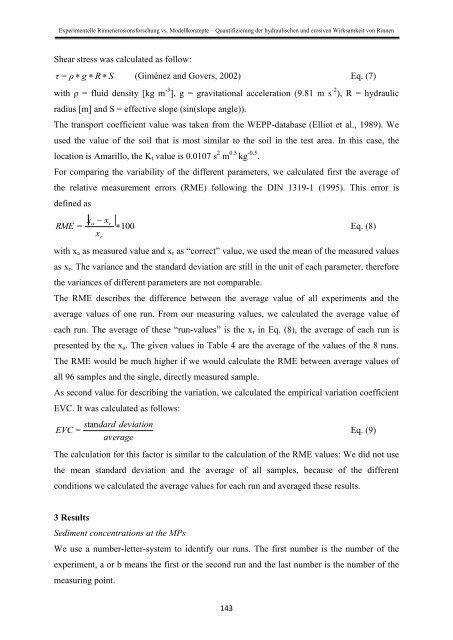Stefan Wirtz Vom Fachbereich VI (Geographie/Geowissenschaften ...
Stefan Wirtz Vom Fachbereich VI (Geographie/Geowissenschaften ...
Stefan Wirtz Vom Fachbereich VI (Geographie/Geowissenschaften ...
Create successful ePaper yourself
Turn your PDF publications into a flip-book with our unique Google optimized e-Paper software.
Experimentelle Rinnenerosionsforschung vs. Modellkonzepte – Quantifizierung der hydraulischen und erosiven Wirksamkeit von Rinnen<br />
Shear stress was calculated as follow:<br />
τ = ρ g R S (Giménez and Govers, 2002) Eq. (7)<br />
with ρ = fluid density [kg m -3 ], g = gravitational acceleration (9.81 m s -2 ), R = hydraulic<br />
radius [m] and S = effective slope (sin(slope angle)).<br />
The transport coefficient value was taken from the WEPP-database (Elliot et al., 1989). We<br />
used the value of the soil that is most similar to the soil in the test area. In this case, the<br />
location is Amarillo, the K t value is 0.0107 s 2 m 0.5 kg -0.5 .<br />
For comparing the variability of the different parameters, we calculated first the average of<br />
the relative measurement errors (RME) following the DIN 1319-1 (1995). This error is<br />
defined as<br />
xa<br />
xr<br />
RME = 100<br />
Eq. (8)<br />
x<br />
r<br />
with x a as measured value and x r as “correct” value, we used the mean of the measured values<br />
as x r . The variance and the standard deviation are still in the unit of each parameter, therefore<br />
the variances of different parameters are not comparable.<br />
The RME describes the difference between the average value of all experiments and the<br />
average values of one run. From our measuring values, we calculated the average value of<br />
each run. The average of these “run-values” is the x r in Eq. (8), the average of each run is<br />
presented by the x a . The given values in Table 4 are the average of the values of the 8 runs.<br />
The RME would be much higher if we would calculate the RME between average values of<br />
all 96 samples and the single, directly measured sample.<br />
As second value for describing the variation, we calculated the empirical variation coefficient<br />
EVC. It was calculated as follows:<br />
standard<br />
deviation<br />
EVC =<br />
average<br />
Eq. (9)<br />
The calculation for this factor is similar to the calculation of the RME values: We did not use<br />
the mean standard deviation and the average of all samples, because of the different<br />
conditions we calculated the average values for each run and averaged these results.<br />
3 Results<br />
Sediment concentrations at the MPs<br />
We use a number-letter-system to identify our runs. The first number is the number of the<br />
experiment, a or b means the first or the second run and the last number is the number of the<br />
measuring point.<br />
143
















